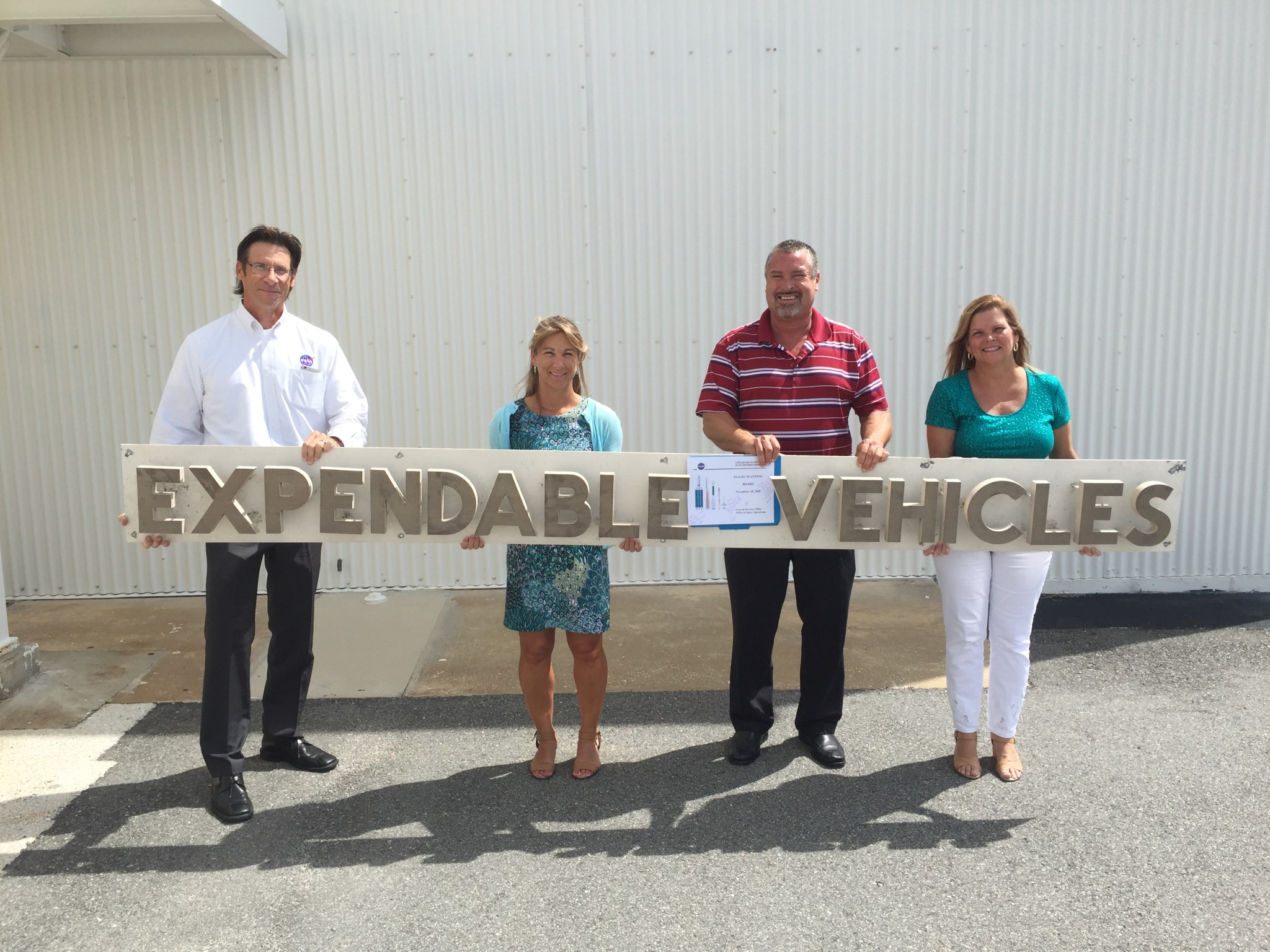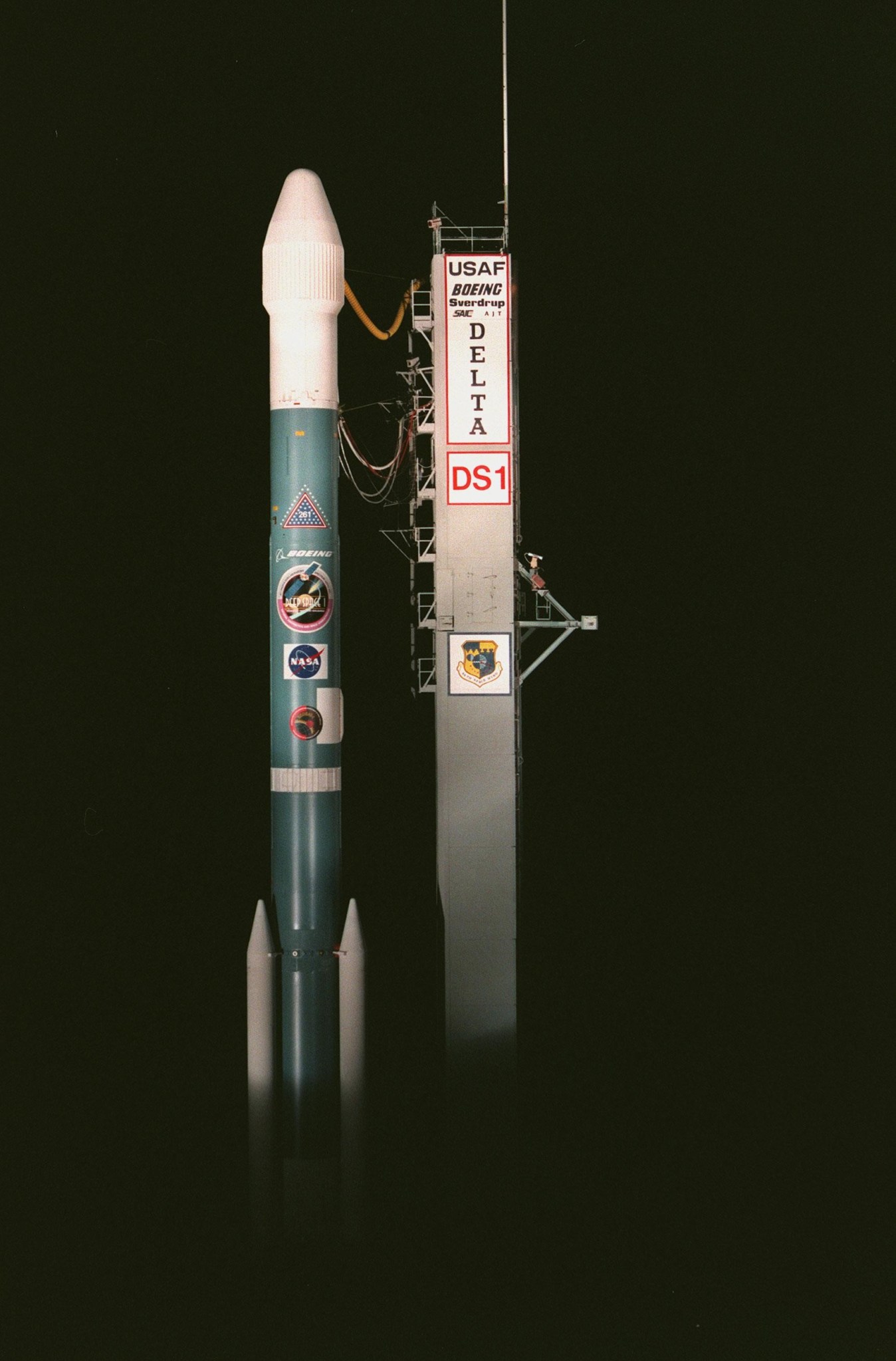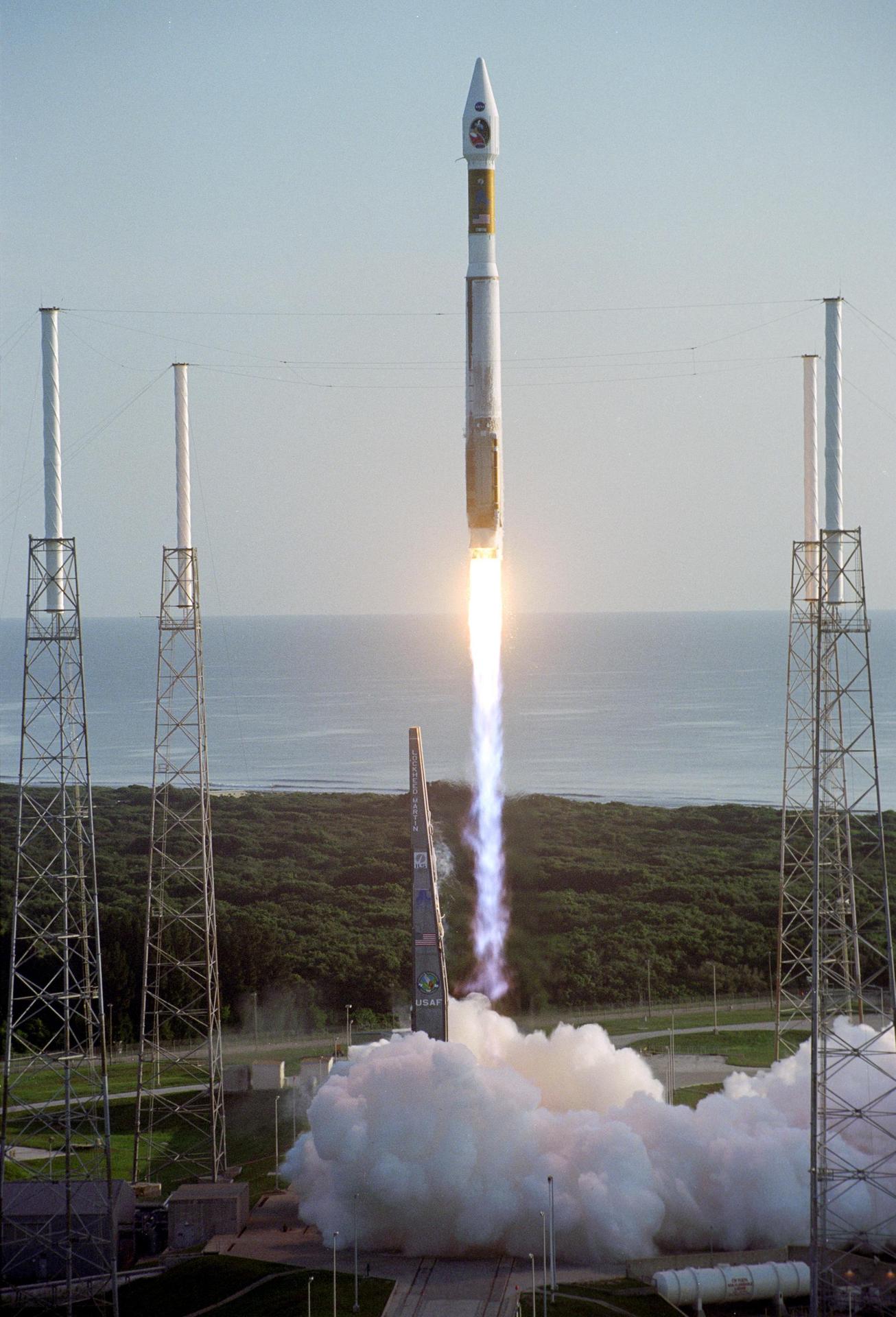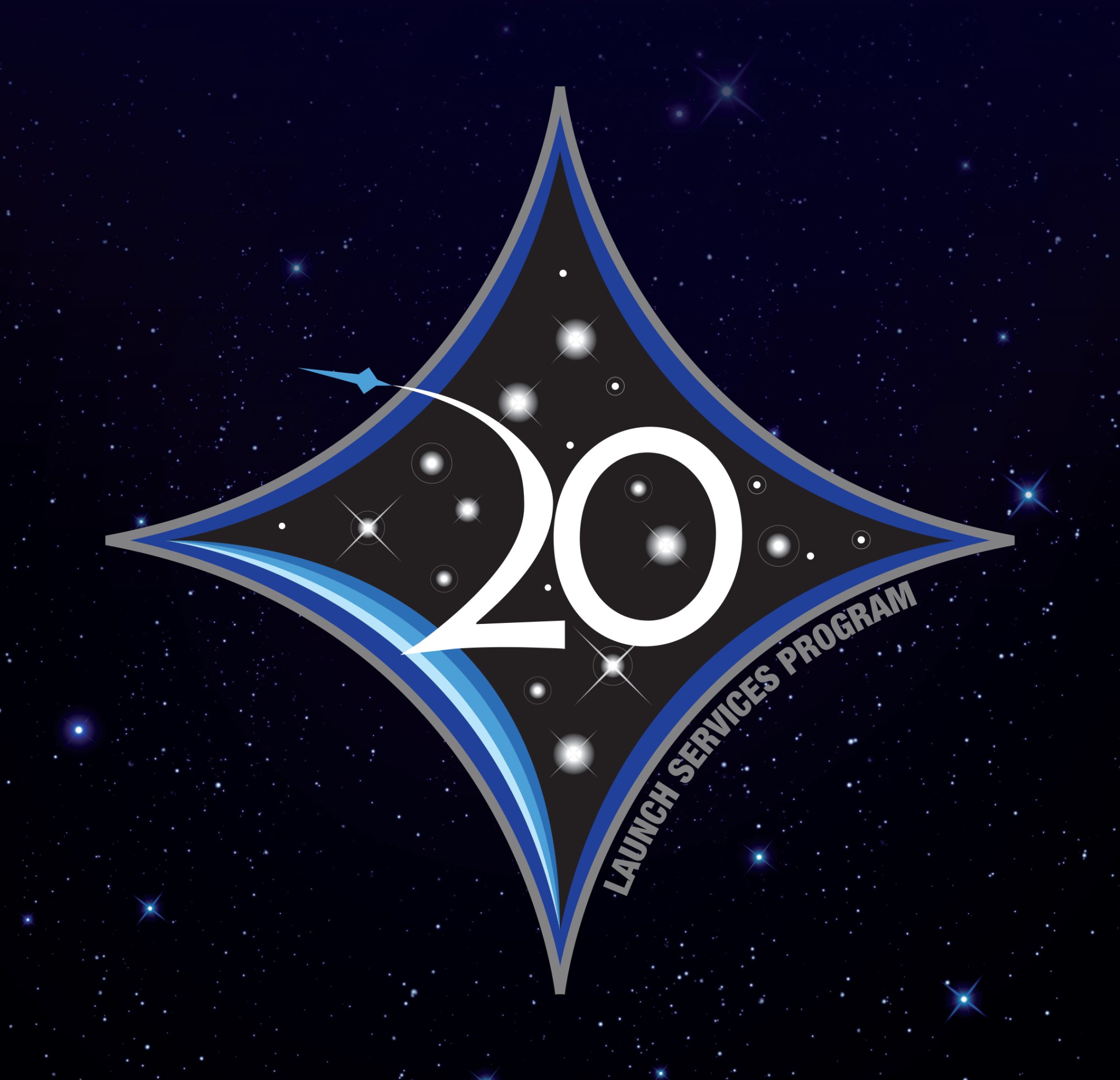By Linda Herridge
NASA’s John F. Kennedy Space Center
While NASA is celebrating its 60th anniversary as an Agency, NASA also is celebrating the 20th anniversary of the Launch Services Program (LSP), the first agency program managed at NASA’s Kennedy Space Center in Florida. Two decades ago, on Oct. 1, 1998, NASA consolidated expendable launch vehicle services shared by Glenn Research Center in Cleveland, Ohio; Goddard Space Flight Center in Greenbelt, Maryland; and Kennedy, creating the Expendable Launch Vehicle Program. It was then formally named the Launch Services Program in 2002.
Before consolidation, Glenn handled the intermediate and large rockets, (i.e. the Atlas and the Titan launch vehicles at the time), and did all of the early mission work and then turned over the responsibility to Kennedy just prior to when the rocket was stacked on the pad. Goddard managed the ultra-light, small and medium rockets, including the Pegasus and Delta II, and then turned over responsibility to Kennedy in the same manner. Kennedy began procuring small class launch vehicles from Goddard with the Small Expendable Launch Vehicle contract awarded in 1998.

“In the 1980s and early 90s, we owned the launch pads and the rockets. Even when it wasn’t a NASA or NASA-sponsored payload, we worked on it,” said Chuck Dovale, LSP deputy program manager. “This is something that most people aren’t aware of.”
When rocket launchers were commercialized in 1989, NASA began working only its own missions. Nearly 10 years later, the transition to LSP took place. The consolidation brought together technology, business, procurement, engineering best practices, strategic planning, and cutting-edge techniques under one roof.
LSP achieved its 90th mission with the recent launch of NASA’s Ice, Cloud and land Elevation Satellite-2 (ICESat-2), on the final Delta II rocket, provided by United Launch Alliance, from Vandenberg Air Force Base in California, on Sept. 15, 2018. The program also has served in a launch “advisory role” for other missions such as Commercial Resupply Services for the International Space Station, and the recent Gravity Recovery and Climate Experiment Follow-on (GRACE-FO).
As LSP enters the next 20 years, the team takes stock of its past and looks ahead to the future.
With his tagline, “I was LSP before LSP was LSP,” Dovale has been at Kennedy since 1982. He’s worked in LSP since starting as a co-op student in 1984. In 1994 he became the Avionics Branch chief. He served as alternate launch director for the Cassini mission to Saturn in 1997, and worked his way up to senior launch director before becoming deputy of the program in 2010.
Dovale’s first mission as launch director was Landsat-7, which launched April 15, 1999, on a Delta II rocket from Vandenberg. His final mission as launch director was the Wide-field Infrared Survey Explorer, launched Dec. 14, 2009, also on a Delta II rocket from the California launch site.

“It’s good to stand back and take a look at what LSP provides,” Dovale said. “Some highlights include missions to other planets, landing rovers on Mars, satellites orbiting our planet and others to study land, sea, ice, carbon buildup, and sending back images. Ultimately, we’re also helping humans get to Mars.”
One of his favorite missions is the Phoenix Mars Lander, for which he was launch director.
The current NASA Launch Directors, Omar Baez and Tim Dunn, each have unique paths that brought them to LSP and eventually to their current roles. Baez was a hydrogen engineer for the Space Shuttle Program before moving to LSP in May 1993, while Dunn came from the U.S. Air Force.
Baez was a mechanical and propulsion engineer for the Titan, and also worked on Atlas, Delta and the Scout Program for several years. He also worked on the Titan IV and the Titan IVB, which was used to launch Cassini. After Cassini launched in 1997, Baez transitioned from being a systems engineer to a mission manager even before the transition or consolidation at Kennedy became official. He was one of the original mission managers, and worked on Genesis before becoming launch director in 2000. Baez’ first mission was Tracking and Data Relay Satellite-H, which launched on June 30, 2000, on an Atlas II-A, from Cape Canaveral Air Force Station in Florida. Baez’ memorable missions include Mars Exploration Rovers A and B, which were renamed Spirit and Opportunity, and the Spitzer Space Telescope. He was launch director for the recent Parker Solar Probe, launched Aug. 12, on a Delta IV Heavy rocket from the Cape.
“Looking ahead, I think the next big mission will be Mars 2020, on an Atlas V from Space Launch Complex 41,” Baez said. “I am also looking forward to some of the new smaller-class rockets such as RocketLab’s Electron or Virgin Orbit’s Launcher One!.”
In the late 1980s, Dunn worked on Global Positioning Satellites with the Air Force in Colorado. He made the move to the Cape to work on the Titan IV as an Air Force launch controller in 1993. In 1996, he made the move to McDonnell Douglas to work on the Delta II, a rocket that would become a favorite. Dunn joined LSP in late 2000 as an electrical engineer for Guidance and Navigation, and then a vehicle systems engineer, both for the Delta II. “At that time, the Delta II was the industry workhorse,” Dunn said. From 2009-2011, he was the LSP certification manager for new rockets, including the SpaceX Falcon 9. In early 2011, he made the move to LSP launch director.
“My first mission was the Gravity Recovery and Interior Laboratory (GRAIL), which launched Sept. 11, 2011, aboard the last Delta II rocket to fly from the Cape,” Dunn said. His memorable missions include IRIS, his first Pegasus mission as launch director, and Jason-3, the first NASA LSP launch on a SpaceX Falcon 9.

“I look forward to LSP’s future in working alongside the commercial providers to bring newer rockets, both small and large, into the NASA catalog of available launch services,” Dunn said. “LSP’s expertise and flexibility will allow us to bring new rockets online and maximize mission assurance for our customers.”
Bobbi Gnan was at Kennedy during the creation of LSP. She is chief of the LSP Business Office and has been in that position for 15 years. Prior to that she worked in the payloads program control office.
“It was an exciting time, but also a chaotic time when the contracts were transferred to Kennedy,” Gnan said. “We were melding three teams together and we had to come up to full speed in a short amount of time.” That’s because the new program’s first mission was Deep Space 1, which launched Oct. 24, 1998, on a Delta II from Space Launch Complex 17 at Cape Canaveral Air Force Station. To help LSP prepare for the transfer of work, Gnan traveled to Goddard in early 1998 to understand the budgets and launch service contracts prior to standing up the program at Kennedy.
“The challenge was that we had a small percent of management of the entire program’s responsibility prior to 1998,” Dovale said. “Then we inherited the rest of the program with no idea of how to organize it and with little to no personnel to accomplish that giant task.”
Some of the workforce came from Glenn and Goddard. Two of them, still with the program, are Darren Bedell, a launch services development and risk manager, from Goddard; and Mike Carney, chief, Flight Analysis Division, from Glenn (formerly Lewis Research Center).
Carney supported the Launch Vehicle Project Office at Glenn, which performed a similar role as LSP today, but only for the Atlas/Centaur and Titan III and IV launch vehicles. He supported the nuclear launch approval process for the Cassini mission. He worked flight design for several missions, including Geostationary Operational Environmental Satellite (GOES-I), and the Solar and Heliospheric Observatory (SOHO).
“The first two years were very challenging,” Carney said. “It was a difficult period, but also very exciting and rewarding.” Two of Carney’s most memorable missions are Pluto New Horizons and Parker Solar Probe.

Bedell, who is now the program technical integration manager, worked in Goddard’s resident office in Huntington Beach, California, where the Delta II was managed. He describes the first few months in LSP as managed chaos.
“We launched seven missions in our first 12 months, and another four in the next 12 months,” Bedell said. “While the launch operations piece was well known by most of the workforce, very few knew about the mission integration or vehicle analysis and hardware qualification.” Bedell’s most memorable missions include the Mars Reconnaissance Orbiter, which launched on the first Atlas V to be used by the U.S. Government! “Also, the Mars Climate Orbiter, Mars Lander and Stardust, these are what I call the ‘Planetary 3-peat’,” Bedell said.
“We have done some great things, we have made some mistakes, and some of what we do will have to change over time,” Bedell said. “But if we remember why, then our future leaders will be able to evolve our service to meet our customers’ needs and the ever-changing landscape of new vehicles.”
Looking ahead, Dovale said that the LSP is in the planning stages for 50 to 60 missions, including providing advisory services to NASA’s James Webb Space Telescope and the Commercial Crew Program.
“In 2021 and 2022 we will have many missions, with many launching from Vandenberg,” Dovale said. “And soon we’ll be on-ramping several new launch vehicles with different configurations, including Blue Origin’s New Glenn Rocket, and ULA’s next-generation Vulcan, as well as SpaceX’s Big Falcon Rocket.”
“LSP is special because of the people,” Dunn said. “The LSP team is composed of amazing people with a variety of government and commercial backgrounds and experience who possess world-class knowledge of what it takes to successfully integrate and launch rockets. That’s what makes this program special.”


























